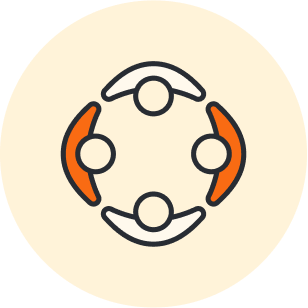Former CEO of Hewlett-Packard, Carly Fiorina, had this to say about the importance of data: “The goal is to turn data into information, and information into insight.”
Whether it’s gut instinct, natural charisma, or sheer force of will, most successful sales professionals find themselves relying on at least one innate skill to gain a competitive edge.
However, the ability to predict, observe, or influence customer behavior with any degree of accuracy takes more than sales prowess alone. It requires data. And lots of it. Over the past 20+ years, customer relationship management (CRM) systems like Salesforce have helped companies better focus their efforts on those prospects most likely to become customers.
Before deciding just how much time and money your company should invest in big data, it’s important to understand what a data-driven sales strategy is and how it works.
Let’s get started.
Understanding the basics of a data-driven sales and marketing strategy
A data-driven sales strategy leverages the data and information being collected during every sales interaction to help personalize sales messaging, better anticipate the needs of customers, and create repeatable success with prospects.
With data on your side, you can determine which offers to promote, what day of the week to suggest them, and who the ideal targets for your sales pitch are. Data also helps companies better identify their most loyal customers. With all of this information in hand, companies are prepared to assess where they are losing or gaining market share and predict when (or if) a sales team’s quota will be achieved.
This data-driven approach is also great for your bottom line. According to a survey by Hubspot, 44% of sales leaders that expected to exceed revenue targets in 2020 used competitive intelligence and market data. And 54% of sellers say sales tools help them close more deals.
“Data is table stakes now. I mean, you can’t sell without data,” says Matt Heinz, president of Heinz Marketing.
Welcoming a data-driven sales strategy is one thing. Putting it into practice is another. Even with considerable resources, it will take time, patience, and hard work before your dream of adopting a data-driven sales approach across your organization becomes a reality. However, using big data will ultimately pay off in three critical areas of your sales strategy.
A data-driven strategy for generating new leads and sales prospects
When it comes to sales, cold calling (soliciting prospects who haven’t had prior direct contact with a salesperson) is a common lead-generation activity. However, giving a sales pitch to someone whose familiarity with your product or service is likely uncertain at best is not only challenging but unnerving. Especially for new sales reps.
Fortunately, a data-driven sales strategy can take the guesswork out of cold calling.
Many businesses attract new sales leads through gated content. This type of content can include case studies, white papers, and other exclusive forms of media offered free in exchange for a person’s name, phone number, and work email address.
The more valuable (and relevant) your content is to potential customers, the more likely those prospects will share their contact information. If your content also serves to educate your prospects about your product, you can anticipate even better quality leads.
Determining the sales readiness of your prospects also falls under the realm of data analysis. For example, gathering demographic and behavioral data on prospects as they engage with ads and interact with your company’s website can provide many actionable insights. Your sales team will know which prospects need nurturing and more follow-up messages.
Data analysis also highlights your most qualified leads, those people who are ready to become customers. As a result, sales representatives become more effective and efficient at their jobs and prospects will begin to feel they’re getting the right amount of attention at the right time.
A data-driven strategy for maximizing the value of existing customers
Most everyone has heard the sales maxim, “it costs 5x more to acquire a new customer than it costs to keep a current one.” A data-driven sales strategy not only helps you sell to new customers—it can help you sell even more to your existing customers.
In fact, the probability of selling to an existing customer is between 60% and 70%, compared to the probability of selling to a new customer, which is just 5% to 20%. And existing customers are 31% more likely to spend more on their average order value with your business
Having a data-driven sales approach can help you improve customer retention by recognizing the behaviors and signals that may indicate that a client relationship is at risk.
For example, many Fortune 500 companies rely on the Net Promoter Score, a real-time loyalty metric that measures a customer’s likelihood of recommending your product, service, or sales representative to their friends, family, or business associates. Net Promoter Scores can be used to trigger warnings when customer loyalty is at risk (i.e. when the number of Detractor scores by respondents outweigh Promoter scores).
LinkedIn Sales Navigator is another helpful tool for data-driven sales departments. Capitalizing on the power of its 660 million-plus member network, sales professionals are able to find new prospects and build customer relationships with modern selling techniques.
With LinkedIn Sales Navigator, your team will be able to:
- Save every lead and sales account to your CRM with one click.
- Stay current on accounts and gather relevant insights.
- Take notes to sync back to your CRM for better sales account organization.
- Get customized lead recommendations from companies you’re targeting.
When it comes to achieving sales quotas and growing your business in a competitive environment, maximizing the value of existing customers is critical. By implementing a data-driven sales approach, the ROI of your sales efforts may prove to be exponential.
A data-driven strategy for improving the overall customer sales experience
Of course, data analysis isn’t just effective for attracting new customers to your company’s website or keeping your best clients from switching accounts to one of your competitors. A data-driven approach also allows you to offer a more personalized, customer-centric sales experience.
From tracking recent sales activity to observing which marketing efforts are the most effective, the active and passive data you collect within your CRM can provide helpful insights about your customers. Using this information, your sales representatives can make product recommendations with greater authority, timeliness, and relevance.
Over time, adhering to a data-driven sales strategy helps you pinpoint your ideal audience segments, model your lead acquisition accordingly, and boost the effectiveness of your campaigns. With a better understanding of your customers, you’ll have the knowledge to update existing service offerings and create new products with more built-in appeal.

Take the next step and learn how to create a data-driven sales organization.
Learn howAbout Lucidchart
Lucidchart, a cloud-based intelligent diagramming application, is a core component of Lucid Software's Visual Collaboration Suite. This intuitive, cloud-based solution empowers teams to collaborate in real-time to build flowcharts, mockups, UML diagrams, customer journey maps, and more. Lucidchart propels teams forward to build the future faster. Lucid is proud to serve top businesses around the world, including customers such as Google, GE, and NBC Universal, and 99% of the Fortune 500. Lucid partners with industry leaders, including Google, Atlassian, and Microsoft. Since its founding, Lucid has received numerous awards for its products, business, and workplace culture. For more information, visit lucidchart.com.
Related articles
Lucidchart as a Sales Tool: How You Can Sell Efficiency in a Single Diagram
One diagram can help a potential customer visualize the way your product will fit into their company. Read how sales reps use Lucidchart to show value.
How to structure your sales organization for success
The way you structure your sales organization can have lasting consequences for your business’s long-term success. Take a look at three common sales team models as well as best practices for creating a successful organization.
How Lucidites use Lucidchart: Diagrams from sales
Our sales org at Lucid uses diagrams for training, sales process mapping, clarifying rules of engagement, and many other areas. Click to see examples!
7 strategies for creating a data-driven culture
Learn the hallmarks of a data-driven culture (with examples from Lucid) and what you can do to build and maintain this type of culture throughout your business, from your entry-level workers to your C-suite executives.

